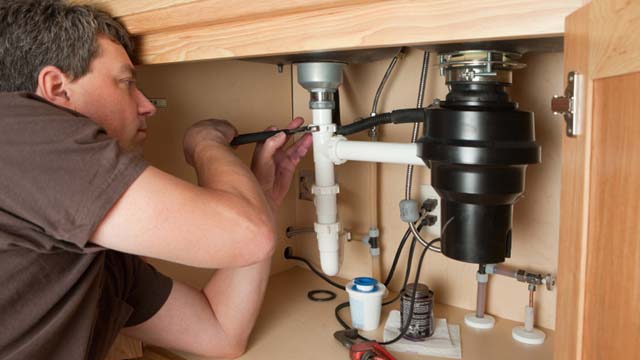Effective Techniques for Repairing a Dripping Garbage Disposal
Effective Techniques for Repairing a Dripping Garbage Disposal
Blog Article
Just how do you actually feel in relation to Why Is ?

Waste disposal unit are essential kitchen devices that aid in taking care of food waste successfully. Nonetheless, a dripping garbage disposal can be a frustrating and unpleasant issue to handle. Fortunately, several leakages can be fixed conveniently with a few straightforward steps. In this write-up, we will review how to deal with a leaking waste disposal unit successfully.
Intro
Garbage disposals are mounted under kitchen sinks and are created to shred food waste right into smaller pieces, enabling it to go through the pipes system conveniently. While these tools are normally trustworthy, leakages can happen in time due to damage, loosened connections, or damages to the system.
Step-by-Step Guide to Dealing With a Leaking Garbage Disposal
Switch off the Power
Before trying any type of repair work, ensure that the power to the waste disposal unit system is turned off to avoid the risk of electrical shock.
Locate the Leak
Recognize the precise area of the leakage and determine the reason
Tighten up Connections
Make use of a wrench to tighten any type of loose connections between the disposal system and the plumbing system.
Replace Seals or Gaskets
If the leakage is due to used seals or gaskets, eliminate the old components and change them with brand-new ones.
Patching Cracks or Openings
For cracks or openings in the disposal system, usage epoxy or a suitable patching product to secure the damaged area.
Determining the Resource of the Leakage
Before attempting to deal with a leaking waste disposal unit, it is essential to determine the resource of the leak. This can usually be done with aesthetic inspection or by carrying out straightforward tests.
Visual Inspection
Inspect the garbage disposal unit thoroughly for any signs of water leakage. Pay close attention to locations around seals, gaskets, and connection factors.
Examining for Leakages
One method to evaluate for leaks is by running water via the disposal system and checking for any visible indicators of leak.
Common Causes of Leakages in Trash Disposals
Worn Seals and Gaskets
Seals and gaskets play an important role in stopping water from leaking out of the garbage disposal. Gradually, these components can wear away, leading to leaks around the disposal system.
Loose Connections
The links in between the garbage disposal and the plumbing system can end up being loosened in time, triggering water to leakage out throughout procedure.
Cracks or Openings in the Disposal System
Physical damages to the garbage disposal, such as cracks or openings in the real estate, can additionally result in leaks.
Tools and Materials Needed for Taking Care Of a Dripping Waste Disposal Unit
Prior to starting the repair process, collect the essential devices and products, consisting of a screwdriver, flexible wrench, plumbing professional's putty, substitute seals or gaskets, and epoxy or patching product for fixing fractures or openings.
Testing the Garbage Disposal After Repair
Once the fixing is total, evaluate the garbage disposal by running water via it to make sure that the leak has actually been settled.
Preventive Upkeep Tips to Stay Clear Of Future Leaks
To stop future leaks, it is essential to execute regular upkeep on your garbage disposal. This consists of maintaining it clean, staying clear of placing non-food items or difficult objects down the disposal, and regularly looking for leaks or other problems.
Verdict
Finally, dealing with a dripping waste disposal unit is a reasonably uncomplicated procedure that can be finished with standard devices and products. By adhering to the actions laid out in this write-up and exercising preventative maintenance, you can keep your waste disposal unit in good working problem and prevent expensive repair work in the future.
What to Do About a Leaking Garbage Disposal
A leaking garbage disposal often goes unnoticed until you confront a sopping cabinet, a foul-smelling puddle, or an audible drip-drip-drip from the unit. The fix can be frustrating, too, because the leak can stem from a number of components in the system. Fortunately, with a little sleuthing, you can zero in on the leak and—depending on the exact location—stop the icky oozing and repair the component that caused it. Worst case scenario, if it turns out that the garbage disposal must be replaced, installing a new one is a reasonable do-it-yourself task for those with basic plumbing skills. Read on to keep the cash you’d otherwise hand over to a pro.
Prepare to find the leak
Prior to testing the garbage disposal for leaks, unplug it at the wall outlet and turn off the power from the breaker box to prevent electrical shock. Then insert a watertight sink stopper into your sink drain and wipe the unit dry with a clean cloth. In any handy container, mix a few drops of food coloring into a few cups of water, and pour the dyed water onto the sink stopper to help you locate the leak.
Investigate the source
the top, where the disposal meets the sink drain the side, where the dishwasher hose or main drain pipe connects to the disposal or the bottom of the unit Inspect each of these locations while gliding a light-colored rag over the unit; the dyed water will readily show on the rag and reveal the location of the leak. If a leak isn’t immediately apparent, remove the sink stopper and pour a few more cups of dyed water down the sink drain, then check for leaks again. Leaks near the top of the unit are more likely to show themselves while the sink is plugged, while side and bottom leaks are more noticeable while the sink is unplugged.
The metal sink flange that sits directly inside the sink drain is typically sealed around the top with plumber’s putty (a clay-like sealant) and then secured from under the sink with bolts. If the plumber’s putty deteriorates, or the bolts loosen, the flange can no longer form a watertight seal between the sink drain and the disposal—which could cause a leak at the top of the unit.
To reseal the leaky flange, you must first detach the garbage disposal. Start by loosening the screws securing the main drain pipe to the disposal, then loosen the screws in the metal clamp securing the dishwasher hose to the disposal and detach the drain pipe and dishwasher hose from the disposal. Loosen the screws in the mounting ring that connects the disposal to the metal mounting assembly beneath the sink, then pull down the disposal and carefully set it on a clean, dry surface. Loosen the bolts in the mounting assembly with a wrench, then pull down the mounting assembly and set it near the disposal.

I discovered that piece about Tips on Fixing a Leaking Garbage Disposal when browsing on the internet. Sharing is good. Helping people is fun. Thanks a lot for your time. Kindly visit our site back soon.
Give Me A Quote! Report this page